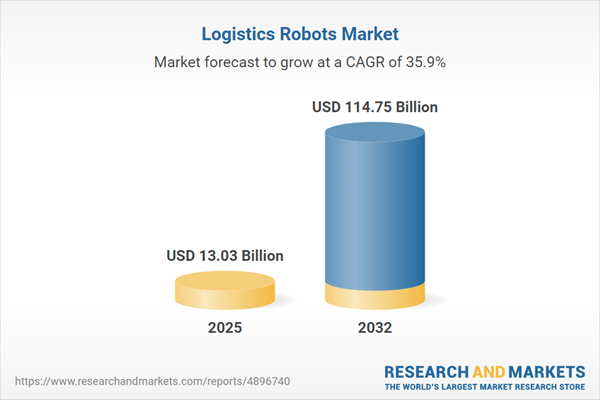Speak directly to the analyst to clarify any post sales queries you may have.
The logistics robots market is rapidly transforming global supply chains by enhancing operational agility, reliability, and speed. Senior decision-makers are adopting robotics solutions to address workforce constraints and evolving customer expectations, positioning automation as a driver of business resilience and future competitiveness.
Market Snapshot: Logistics Robots Market Growth and Opportunity
The logistics robots market grew from USD 9.85 billion in 2024 to USD 13.03 billion in 2025. It is expected to continue growing at a CAGR of 35.91%, reaching USD 114.75 billion by 2032. This trajectory reflects robust enterprise investments in autonomous systems, surging digitalization across supply networks, and increasing prioritization of technology-led efficiency. Market expansion is anchored by demand for adaptable, intelligent automation capable of meeting variable fulfillment requirements in both established and emerging economies.
Scope & Segmentation: Comprehensive Market Breakdown
- Robot Types: Automated guided vehicles, autonomous mobile robots, collaborative robots (cobots), drones and unmanned aerial vehicles, exoskeletons, robotic arms.
- Functions: Palletizing and depalletizing, picking and packing, sorting, transportation and delivery, warehouse management.
- Payload Capacities: High-capacity (above 500 kg), medium-capacity (100–500 kg), low-capacity (up to 100 kg).
- Power Sources: Battery-powered, hydrogen fuel cell, solar-powered robots.
- Applications: Indoor and outdoor deployment environments.
- End-Use Verticals: Airports and ports, cold storage, factories and manufacturing plants, retail stores and supermarkets, warehouses and distribution centers.
- Regions: Americas (including North America and Latin America), Europe, Middle East and Africa (including individual countries), Asia-Pacific (including China, India, Japan, Australia, and more).
- Companies Profiled: Coverage includes automation leaders and innovators such as Amazon.com, Inc., FANUC CORPORATION, Honeywell International Inc., Toyota Material Handling, Inc., Daifuku Co., Ltd., Zebra Technologies Corporation, and over 15 additional key technology providers.
Key Takeaways for Senior Decision-Makers
- Adoption of robotics in logistics is reshaping inventory handling, responding to labor shortages, and streamlining last-mile delivery models in both structured and dynamic environments.
- Advancements in machine learning, sensor fusion, and computer vision are enabling robots to operate collaboratively with human teams while maintaining high reliability and safety standards across operational workflows.
- Deployment strategies are increasingly customized to address industry-specific needs, such as temperature-sensitive operations in cold storage or enhanced dexterity in retail order picking.
- Integration of cloud-based orchestration and modular hardware platforms is allowing enterprises to quickly adapt to seasonal fluctuations and shifting regulations across global value chains.
- Competitive differentiation is now achieved through strategic partnerships, intellectual property development, and accelerated product innovation targeting regional regulatory requirements and end-user expectations.
Tariff Impact: Strategic Supply Chain Reconfiguration
Recent tariff actions by the United States are driving a reevaluation of logistics robotics supply chain strategies worldwide. Manufacturers are exploring local sourcing, nearshoring, and dual-supply models to manage increased costs for electronic components and subsystems. These adjustments may extend lead times and require revised validation protocols, but they are proving essential in mitigating risk, maintaining cost efficiency, and ensuring reliable product delivery despite ongoing geopolitical uncertainties.
Methodology & Data Sources
This analysis is built on robust primary interviews with industry stakeholders and in-depth secondary research across trade publications, patents, and financial records. Advanced modeling and peer validation ensure objectivity and actionable insight throughout the report.
Why This Report Matters to Logistics Leaders
- Enables strategic planning for adopting logistics robotics tailored by sector, function, and geography.
- Empowers teams to anticipate regulatory and technology-driven disruptions while maximizing return on automation investments.
- Offers benchmarking intelligence on leading technology providers and emerging upstarts reshaping the market landscape.
Conclusion: Preparing for the Next Era of Logistics Excellence
Logistics robotics are redefining competitive boundaries by connecting machines, people, and data across supply chains. Leaders who align robotic innovations with broader digital transformation will drive operational resiliency and sustained enterprise growth.
Additional Product Information:
- Purchase of this report includes 1 year online access with quarterly updates.
- This report can be updated on request. Please contact our Customer Experience team using the Ask a Question widget on our website.
Table of Contents
3. Executive Summary
4. Market Overview
7. Cumulative Impact of Artificial Intelligence 2025
Companies Mentioned
The companies profiled in this Logistics Robots market report include:- Alstef Group
- Amazon.com, Inc.
- Asic Robotics AG
- Clearpath Robotics, Inc. by Rockwell Automation Inc.
- Comau S.p.A.
- Daifuku Co., Ltd.
- FANUC CORPORATION
- Grenzebach Maschinenbau GmbH
- Hitachi, Ltd.
- Honeywell International Inc.
- Kawasaki Heavy Industries, Ltd.
- Kion Group AG
- Knapp AG
- Kollmorgen Corporation
- Krones AG
- Midea Group
- Omron Corporation
- Sidel Group
- Teradyne, Inc.
- Toshiba Corporation
- Toyota Material Handling, Inc.
- Vecna Robotics, Inc.
- Zebra Technologies Corporation
Table Information
| Report Attribute | Details |
|---|---|
| No. of Pages | 186 |
| Published | November 2025 |
| Forecast Period | 2025 - 2032 |
| Estimated Market Value ( USD | $ 13.03 Billion |
| Forecasted Market Value ( USD | $ 114.75 Billion |
| Compound Annual Growth Rate | 35.9% |
| Regions Covered | Global |
| No. of Companies Mentioned | 24 |







![Embodied AI Market by Product Type [Robots (Humanoid Robots, Mobile Robots, Industrial Robots, Service Robots, Cobots), Exoskeletons, Autonomous Systems, Smart Appliances], Level of Embodiment (Level 1, Level 2, Level 3) - Global Forecast to 2030 - Product Image](http://www.researchandmarkets.com/product_images/12789/12789166_60px_jpg/embodied_ai_market.jpg)

